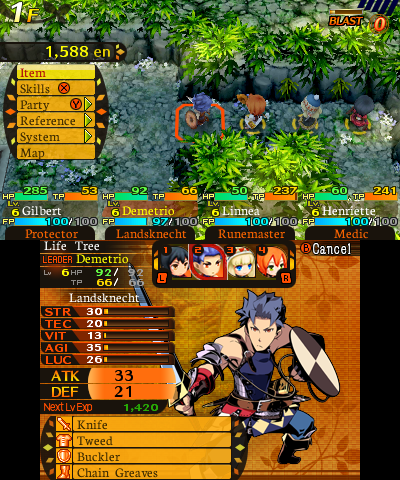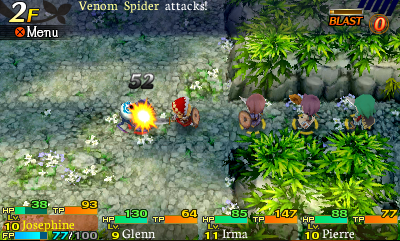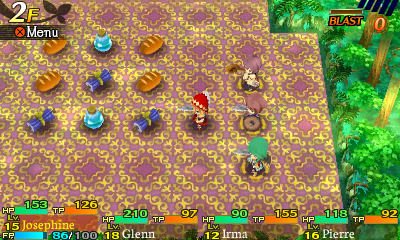
The crossover game between Atlus’ Etrian Odyssey series, and Spike Chunsoft’s Mystery Dungeon series, Etrian Mystery Dungeon, has, as of Friday, reached UK shores at last. Released in Japan earlier this year, in March, and then in the US in April, we have, once again, been treated to a long wait, as seems to be tradition with Etrian Odyssey titles, and, to a lesser extent, Mystery Dungeon titles. Within the UK, there has been limited exposure for both of these series, with the second and third Etrian Odyssey titles remaining unreleased over here. Thankfully, somewhat on the heels of the remake of the first game seeing a UK release last year, the remake of the second game will be released over here in February 2016, though it’s 6 months after the US release. At least they’re consistently released late in the UK. It’s easy to see why many a fan think Atlus have some sort of issue with Europe; it seems that were it not for NIS America, many of these titles would likely never see release over here. For a region-locked console such as the 3DS, that would be most unfortunate.
When it comes to the Mystery Dungeon series, many UK gamers will likely only have experienced the Pokémon Mystery Dungeon series, as only two non-Pokémon themed Mystery Dungeon games have seen a PAL release. Having no experience with the Etrian Odyssey series of games, and only limited experience with the Pokémon Mystery Dungeon games, I approached this game as, effectively, a newcomer. This certainly showed during my time with the beginning of the game. The main menu in-game contains 7 options, Kasumi’s Inn, Chano Retail, Amber Restaurant, Explorers Guild, Magan’s House, Stein Labs, and Skyship Port; each of these provides some of the gameplay that makes up Etrian Mystery Dungeon.
Kasumi’s Inn functions primarily as a bank, but also allows you to save the game. You can store any amount of money here, or withdraw it. The number of items you can store depends on the level of the Hotel District, which is improved over at Magan’s House in exchange for your hard-earned money. You can save the game here, and return to the title screen if you wish, though the game does auto-save at times as well. If you’re so inclined, you can also chat to Kasumi, though this seems pointless and amounts to basically a couple of sentences related to the main quest you’re currently undertaking.
Chano Retail is, as the name implies, the shop, affected by the Market District level. It is here that you can both buy and sell weapons, armour, accessories, and items. You can also sell materials that you collect in dungeons and from drops. Selling these materials to the shop unlocks more products to buy, and enables you to forge your weapons and/or armour to give them additional effects. These effects fill slots that each weapon or piece of armour has available. Once again, you can chat with the proprietor to read a little about how the current main quest relates to them. Pricing in the shop is acceptable, especially when you can rake in 1500en from one quick excursion through the first dungeon with minimal effort.
Amber Restaurant serves two main functions; you can order food, which bestows effects on the characters that partake during their next excursion into a dungeon, and you can accept quests from the townspeople. This is also where DLC quests are accepted. The quests available here do not impact on which dungeons are unlocked for exploring, but still provide useful rewards, usually in the form of items. You can listen in on customer conversations, which seems pointless, and you can chat with the host; again, just explaining how the current main quest has an impact on them. All these “Chat” options seem completely irrelevant to the game.
The Explorers Guild and Stein Labs, while both beneficial, manage to be the least visited areas of the game. I liked the party I first created, and decided to improve them rather than keep changing the party members; thus far, I only find myself venturing to the Explorers Guild to change the make-up of my team as quests specifically necessitate it. This is also the area where you can enrol new characters in your guild, though after my initial recruitment, I have preferred recruiting characters that appear during excursions to the dungeons. Thankfully, forts allow you to improve your additional guild members without actively playing with them, so they aren’t insanely under levelled when you do need them. You are able to equip your party members with weapons and armour at any point, without needing to enter the Guild. Stein Labs exists solely for labyrinth research, allowing you to read research reports. This is only after you rescue Sarah from the third dungeon, though.
Magan’s House is where you accept missions that progress the main story and unlock more dungeons to explore; these quests tend to offer better rewards than those at Amber Restaurant but are also substantially more difficult. The first mission seemed noticeably harder than later missions, even after reading through all the in-game help. I’m not sure if the excessive grinding in the first dungeon is intentional, but it was almost enough to deter me from the game. After completing this mission, the difficulty seemed to level out, making for a more enjoyable experience. Magan’s House also hosts the Redevelopment options, where you can donate your earned money to improve the town’s districts. This does improve the town to your benefit, at least, you’re not just throwing away cash for no reason. The four districts are Hotel, Market, Eatery, and Guild. Improving the level of these districts increases what is available to you in each of them; though you may not see an immediate benefit from the sometimes costly outlay, you’re sure to reap the rewards as you continue progressing through the game.
Skyship Port is where you will spend most of your time, as this is the entrance to the dungeons. Each dungeon randomly generates every time you enter it, though the stability of them is somewhat preserved after building a fort within them. Building a fort locks the arrangement of the floors in place, though each segment of the dungeon still randomises upon entry. This is a useful mechanic, as it ensures that going through a dungeon a multitude of times does not provide for exactly the same experience each time. Fighting is carried out using a turn-based system; you control the party leader, while the remaining party members act of their own accord. Using Blast Skill, you can enable ‘Command All’ during a battle so that you can control each character’s actions; this is automatically enabled on the lowest floor of each dungeon. Characters have a basic attack, assigned to the “A” button, and can learn multiple skills, which you can assign to a variety of button combinations for easy access. These skills, which may be attacks or effects, utilise your TP. Meanwhile, just moving around seems to drain the Party Leader’s FP; thankfully, you can change the leader at any point to make use of all characters’ FP. Both TP and FP can be restored, alongside HP, with items that you can buy or find in dungeons. Battles all play out basically the same, and you’ll need to go through a lot of them to collect materials, money, and complete quests. So, if you hate grinding, steer clear of this game.






